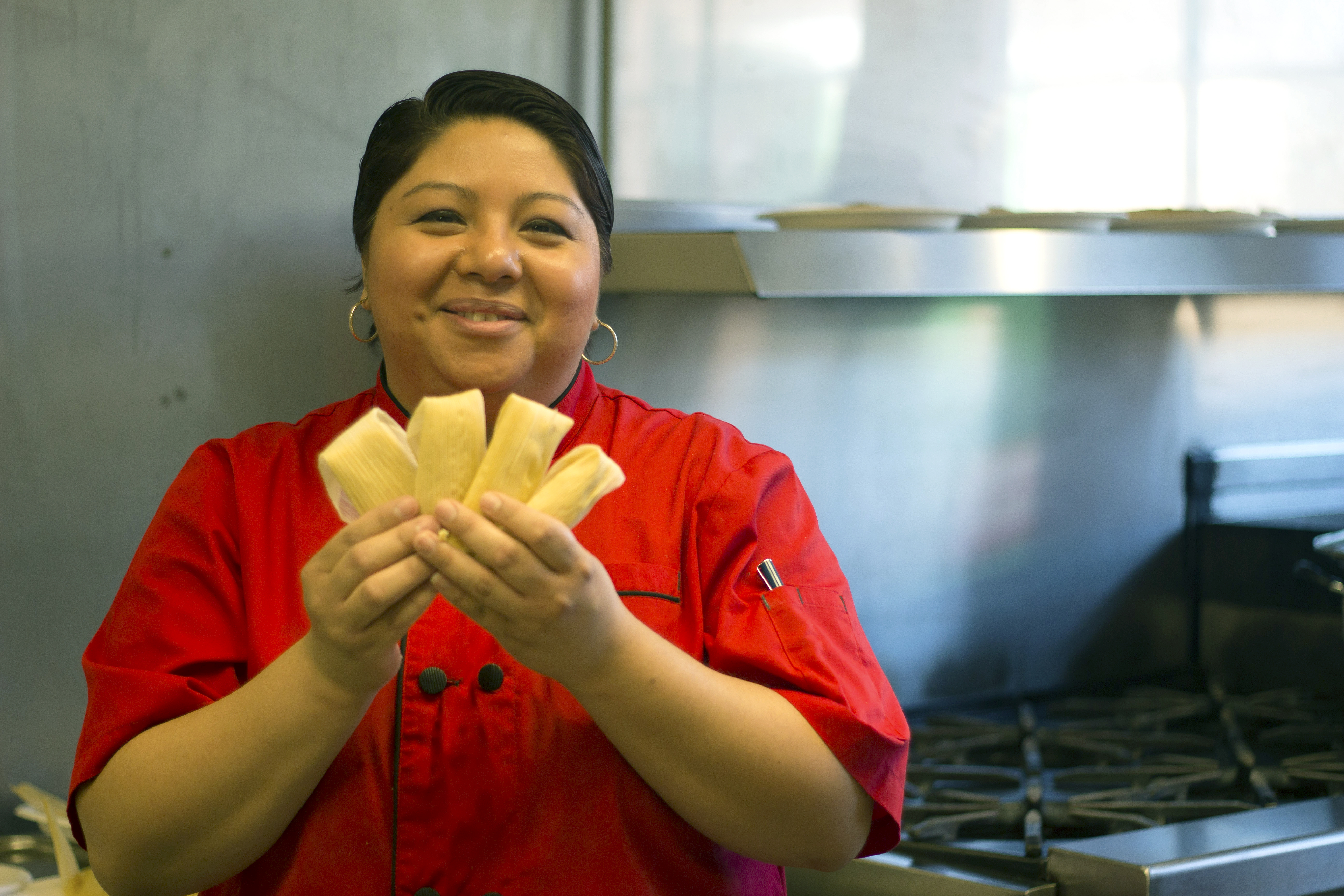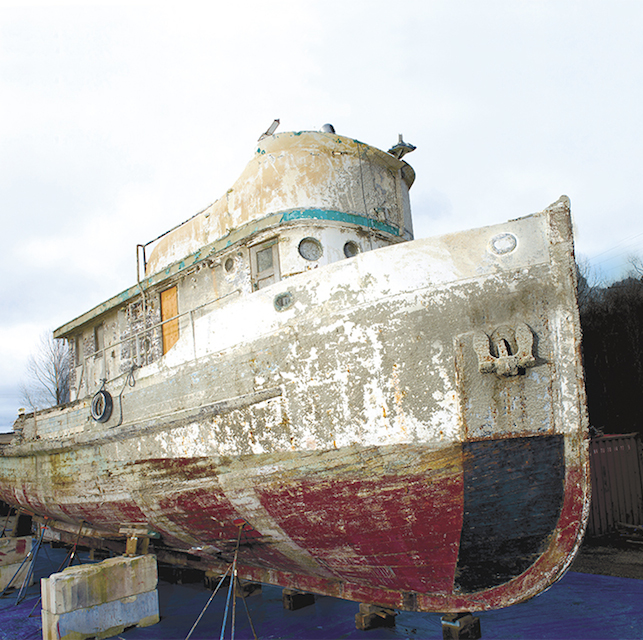It’s 11 a.m. on a Saturday, and I’m learning a few things about tamales. Surrounded by giant mixing bowls of steaming shredded pork, piles of masa stiffened with hot broth, and enough corn husks to make an entire soccer team of scarecrows, I note two things: Don’t spread the masa too thick, and never, ever try to make tamales alone. Luckily, I’m joined by a team who all signed up for the same class: Tamale-Making 101 at Centro de la Raza on Beacon Hill.
Before we begin, our instructor, Jamie Pina Bautista, gives us a brief history of Centro de la Raza (“The Center for People of All Races”) and its founders. In the early ’70s, amid broiling activism nationwide, Seattle’s growing Chicano community was looking for a center—someplace they could gather and support each other in finding affordable housing, assisting with an employment search, or just sharing a hot meal. In a bold move, they chose to occupy the Beacon Hill School, abandoned after closing due to poor attendance. Still without money, they relied on the creative talents and skill sets of their members to renovate the building, and begin to offer services. Led by charismatic activist Roberto Maestas, they managed to create a thriving support community for the city’s Latino population.
Forty years later, Centro de la Raza is doing more than ever. In 2014 alone, the center served 15,063 people, including 8,563 families, and saw positive change through its 52 different programs and services. This Friday they break ground on a new facility, turning the gravel lot between the Beacon Hill School and the light-rail station across the street into 112 units of new, affordable housing, seven classrooms, a 6,000-square-foot multicultural community space, and a spacious plaza with room for 20 micro-retail start-ups. Named after their founder, Plaza Roberto Maestas will also host events like outdoor movie nights and festivals, and provide a place for food trucks. They’ll even open a new commercial kitchen, where an expanded lineup of classes, like my tamale course, will serve even more curious cooks.
As Bautista leads us into the small kitchen where community meals are prepared, she tells us the pork is already made—unnecessarily, as we are all drawn to the distinct aroma of shredded pork like moths to a campfire. The slow braising process—with salt, pepper, and a few cloves of garlic—takes hours. But the delicate strands of pork in front of us are well worth the wait. “Go ahead and try a piece,” instructs Bautista. “If you try it now, you can taste the pork’s flavor change as we add ingredients.” Immediately a flurry of hands shoot into the meat pile, snatching bits of tender, succulent meat. Bautista emits a warm smile and a little chuckle upon seeing our enthusiasm.
We all agree that the texture is right, but the flavor could use a boost. Bautista adds a heavy dose of cumin, and we taste again. Boom—the flavors are far deeper now, and I convince myself that a second taste is necessary, in the name of thorough journalism.
“My recipe is slightly different than my aunt’s, and hers was slightly different than her mother’s. It’s a recipe that goes back to my great-great-grandmother, but we all tweak it a little bit,” explains Bautista as she picks rogue pieces of bone out of the pork.
It was Bautista’s aunt, Graciela Gonzalez, who started the tamale class in 2008. At the time, Centro de la Raza had a problem. Like so many programs and services, the crippling recession was hurting its ability to provide for their community. “No one had money, so we had to figure out new ways of raising funds for ourselves,” remembers Estela Ortega, Centro de la Raza’s current executive director. “We had to get creative, so we started thinking about what we do well, what we could provide for others that was valuable.” They started selling everything from Christmas trees to Spanish classes, reaching out to the broader community to raise funds by sharing Centro de la Raza’s unique skill sets—including that of Gonzalez, known for her killer tamale recipe.
Now in its seventh year, Bautista is happy to have taken over at the kitchen’s helm, continuing the legacy of her family’s recipe and of Centro de la Raza after her aunt moved away. With the pork adequately spiced, we create a smoky red sauce by blending rehydrated arbol peppers. The sauce is mixed with the pork, then with the masa to add a mild bit of color and to deepen the flavors. The masa is then wrestled by hand to a cookie-dough consistency with lard and broth—in a labor-intensive process that doesn’t receive nearly as many volunteers as the call for pork-tasting. Finally it’s time for Bautista to show us how to assemble tamales.
Standing shoulder to shoulder along stainless-steel tables, we learn how to expertly spread the masa and cumin-spiced pork shoulder into wet corn husks, rolling them tightly and pinching the ends so they don’t dry out while steaming. Under Bautista’s helpful guidance, we begin filling one small corn husk at a time. It’s here I realize that making tamales alone would be a tortuous process. It takes my class of 12 about two hours to roll up the 160 tamales created from our pork shoulder.
While it might be the most popular, the tamale class is not the only one Centro offers after expanding the program two years ago. Teaming with Brown Paper Tickets and local volunteer chef Patrick Nelson, the community center started providing cooking classes to a much wider audience. They added pozole and paella to the lineup, along with a more flexible schedule. And it worked. The classes became more successful than ever, raising over $50,000 in 2014 alone—funds which go to the center’s Senior Nutrition and Wellness programs.
As the class comes to a close, our first batch of tamales is just finishing in the steamer, where a penny rattles at the bottom of the pan to tell us that the water is still simmering. Excited students are already asking where they can get their own tamale pot—which makes the cooking process only slightly easier—and making plans for experimentation with new fillings: beef, chicken, pork. One student even asks if picnic ham would be an adequate filling. “Sure!” Bautista emphatically replies. Anything works.
Gathered around the cafeteria tables outside the kitchen, students wait until the corn husks stop steaming. Burning our fingers, we throw caution to the wind and rip open the little packets, desperate for a taste of our new creations. Popping the first bite into ravenous mouths, the fruits of our labor are realized. The final product is fantastic, and I can’t help but wonder how much better they taste solely because of the work that went into making them. Luckily, now I know how.
food@seattleweekly.com
This tamale class costs $75. Fees vary depending on the dish; overall, classes range from $50 (pozole) to $90 (paella). See elcentrodelaraza.org for more information.








